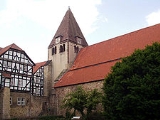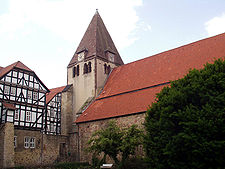
Kaufungen Abbey
Encyclopedia

Kaufungen
Kaufungen is a municipality in the district of Kassel, in Hesse, Germany. It is situated in the narrow valley of the river Losse, surrounded by the steep, wooded hills of the Kaufunger Wald, approx...
in Hessen, Germany
Germany
Germany , officially the Federal Republic of Germany , is a federal parliamentary republic in Europe. The country consists of 16 states while the capital and largest city is Berlin. Germany covers an area of 357,021 km2 and has a largely temperate seasonal climate...
.
In 1532, during the Reformation
Protestant Reformation
The Protestant Reformation was a 16th-century split within Western Christianity initiated by Martin Luther, John Calvin and other early Protestants. The efforts of the self-described "reformers", who objected to the doctrines, rituals and ecclesiastical structure of the Roman Catholic Church, led...
, Count Philip I of Hesse appropriated it and gave it, together with Wetter
Wetter, Hesse
Wetter is a small town in Hesse, Germany. The rather unusual designation Wetter stems from a time when the town belonged to the Prussian province of the same name, and nowadays is only used by the railway – even today, the railway station in town bears this name.-Geography:Wetter lies in the...
Abbey, to the Hessische Ritterschaft ("Hessian Knighthood", an association of noble families for the purpose of mutual help) for the care and shelter of female members of those families belonging to it.
As the Ritterschaftliches Stift Kaufungen it still exists today.
History
In May 1017, the Empress Kunigunde was staying on the imperial estate of Kaufungen, when, according to Thietmar of MerseburgThietmar of Merseburg
Thietmar of Merseburg was a German chronicler who was also bishop of Merseburg.-Life:...
she became seriously ill and vowed to found a monastery if she recovered. She did so and her husband, Emperor Henry II
Henry II, Holy Roman Emperor
Henry II , also referred to as Saint Henry, Obl.S.B., was the fifth and last Holy Roman Emperor of the Ottonian dynasty, from his coronation in Rome in 1014 until his death a decade later. He was crowned King of the Germans in 1002 and King of Italy in 1004...
, endowed the new foundation in 1019. After the death of Henry in 1024, Kunigunde, who was later canonized, retired to the new Benedictine nunnery, where she died in 1040.
The foundation was an Imperial abbey (territorially and judicially independent, subject only to the Emperor).
The "Vögte" (advocates, or lords protectors) of Kaufungen Abbey were the Counts of Maden.
Church
The abbey church, now known as the "Stiftskirche", was dedicated on 13 July 1025. It is now used as the parish church and is counted as the most significant structure of the late Ottonian period in north Hesse. In the westworkWestwork
A westwork is the monumental, west-facing entrance section of a Carolingian, Ottonian, or Romanesque church. The exterior consists of multiple stories between two towers. The interior includes an entrance vestibule, a chapel, and a series of galleries overlooking the nave...
the Imperial gallery ("Kaiserempore") was re-discovered in 1938.

